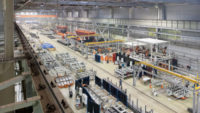Nobody in manufacturing deliberately violates regulations or stirs an unplanned shutdown yet machinery-related injuries consistently make the top 10 list of OSHA violations. Getting ahead of potential issues to keep employees safe and business profitable is one of the primary reasons manufacturers embrace digital transformation.
Insights from Deloitte’s 2024 Manufacturing Industry Outlook reinforce that technology will continue to play a significant role in resolving challenges and activating opportunities related to the data that flows through tools for optimizing talent, smart manufacturing, supply chain, aftermarket, and electrification and decarbonization.
Within this transformational moment is the opportunity for manufacturers to use all this data to elevate their approach to safety - incident reports, occupational health, and safety (OHS) guidelines, compliance standards — to build the rigor to navigate hazardous situations, identify risks, and improve their OHS awareness and response capabilities.
The pursuit of manufacturers making themselves more data-driven has led to the expansion of the tech stack, producing a bit of an opposite effect — instead of making their jobs easier, all those tools and data streams are counterproductive.
Adding to this is the potential disconnect from a mobile-first workforce that relies on the info in their apps while others in the company are tethered to their desktops. This has the potential to create information gaps. As a result, employees are spending too much time looking through those tools for the information they need to do their jobs, eating into the time that could be better spent on activities that will have a real impact on the business. It is an issue of “busy-ness” versus business. The issue is known as Gray Work.
Shift happens
For example, consider the daily shift-to-shift updates. Before a shift can officially start, the project manager or floor supervisor must go through the hot items and clear their high priority inbox. This takes 30 minutes, on average, on a good day.
Now consider what happens when they discover an employee does not have the proper certifications for their assignment, or they missed the notification from a vendor of an upcoming system change. These standard activities can throw a manufacturer off track, resulting in lost productivity and increased safety risks.
One way to avoid these situations is to automate workflows, which is what a lot of manufacturers are doing. But what happens when the workflow does not have a complete picture of what is going on throughout the entire manufacturing process and how that ties into the business? It might be pulling from inaccurate information, or it could be missing important data that is sitting in a digital tool on someone’s desktop. This leads to team members wasting time as they verify information.
One way to eliminate this issue is to shift from relying less on the tools and more on connecting the information in those tools. This connective approach brings data together in a way that makes it easy to manage work, instead of bogging down employees in tedious, repetitive tasks.
Three ways to reduce the risk of OSHA violations
There are benefits to a single, unified view of what is happening in the business and on the production floor. Here are three ways it can reduce the risk of OSHA violations in manufacturing:
1. Identify skills gaps on the manufacturing floor
When employees, especially temporary contractors, do not have the proper training and certifications, it increases the risk of workplace errors and injuries and production delays. Instead of learning after the fact that employees are not fully prepared to work through the shift, a dynamic work management platform could alert the production manager to required certifications and upcoming inspections well in advance so they can plan accordingly.
2. Automation of maintenance requests and improved planning for downtimes
Change is a constant in manufacturing, adding complexity and stress to systems, people, and projects. The process of updating systems and alerting stakeholders is complex, and a single change to any project can lead to ripple effects that slow or stop production. Centralizing information helps you get out ahead of required down time due to equipment maintenance, employee certifications or staffing, and all the other parts of change management.
3. Reporting and documenting incidents is critical to preventing future ones
When information is shared across plants and automatically put into a safety workflow, it reduces the risk of repetitive incidents. Plus, it provides opportunities for training, and upskilling.
For manufacturers, when information is current and easily accessible you can identify trends to reduce safety risks while keeping employees engaged in activities that have a direct impact on the business.



